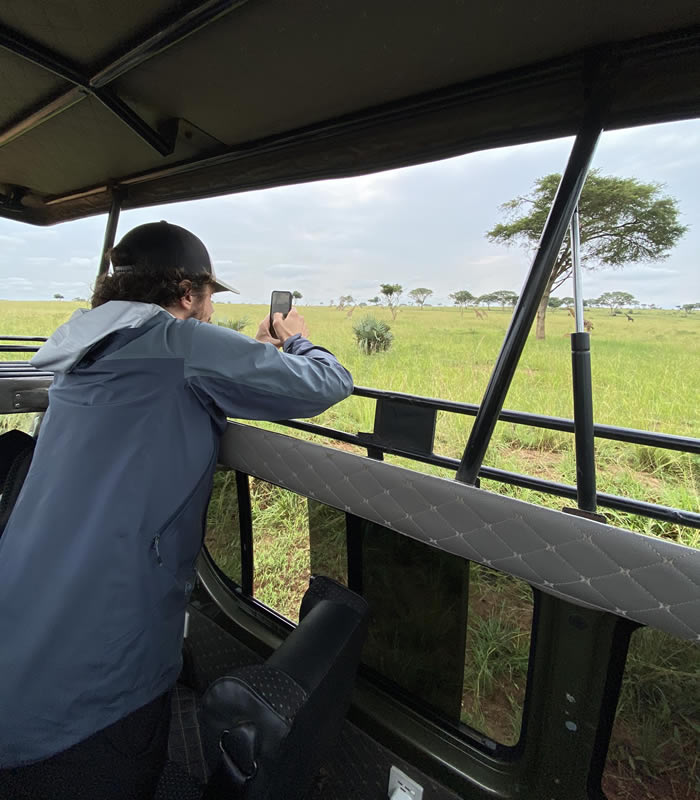Queen Elizabeth National Park, situated in southwestern Uganda, spans an impressive 1,978 square kilometers. Renowned for its rich wildlife, the park attracts thousands of tourists eager to view its diverse game. The park’s varied landscapes, including open savannahs, rainforests, dense papyrus swamps, and expansive Lake Edward, contribute to its status as one of the most biodiverse conservation areas in the world.
 Accessibility
Accessibility
Queen Elizabeth National Park is accessible by both road and air. The drive from Kampala to the park takes approximately 5 to 6 hours via the surfaced road through Mbarara, or alternatively, from Bwindi via a dirt road. For those preferring air travel, private charter flights can be arranged from Entebbe International Airport to Kasese Airstrip.
The Kyambura Gorge
The Kyambura Gorge, located within the park, is renowned for its habituated chimpanzees. Additionally, the remote Ishasha region is famous for its unique tree-climbing lions, a rare sight anywhere in the world.
Maramagambo Forest
Maramagambo Forest, a tropical rainforest within the park, hosts a captivating array of wildlife, including forest monkeys, the elusive forest elephant, and various bird species. The forest is also home to flocks of flamingos on the crater lakes, a bat colony, and the striking Blue Lake.
Mammals
Queen Elizabeth National Park is home to over 100 mammalian species. Visitors can frequently spot large herds of elephants, abundant hippos, the elusive giant forest hog, and the handsome Uganda Kob, especially around the tourist village on the Mweya Peninsula.
Birds
The park is a birdwatcher’s paradise, boasting 606 bird species. Notable species include the Malachite and Pied Kingfishers, White-winged Terns, Swamp Flycatcher, Grey-capped Warbler, Grey-headed Kingfisher, Collared Pranticles, African Jacana, and the Martial Eagle. Rare sightings include the Shoebill Stork, African Skimmer, and Verreaux’s Eagle-Owl. The park also hosts the beautiful Black-headed Gonolek, Great and Long-tailed Cormorants, and various pelicans, storks, and weavers.
Safari Activities
- Game Drives
The park offers several game drive trails where visitors can observe typical African savannah wildlife, including Elephants, Lions, Leopards, Hyenas, Buffaloes, Waterbucks, Uganda Kobs, and Warthogs. The best times for game drives are early mornings and evenings. - Bird Watching
With over 606 recorded bird species, Queen Elizabeth National Park is a haven for bird enthusiasts. The Kazinga Channel is particularly notable for its large numbers of water birds, including White-faced Whistling Ducks, Knob-billed Ducks, Great and Long-tailed Cormorants, and Pink-backed Pelicans. - Launch Trips
A cruise along the Kazinga Channel offers excellent wildlife viewing opportunities. Visitors can see large groups of hippos, solitary buffaloes, elephants, crocodiles, and a variety of water birds such as Pelicans, Egyptian Geese, and African Fish Eagles. - Guided Forest Walks
Guided walks in Maramagambo Forest explore the park’s lush vegetation, including the Blue Lake, Hunters Cave, and Bat Cave, which hosts thousands of Egyptian Fruit Bats. The forest is also home to various medicinal tree species. - Chimpanzee Tracking
Chimpanzee tracking is available in the Kyambura Wildlife Reserve, located in the park’s eastern part. In addition to chimpanzees, visitors may encounter Black and White Colobus Monkeys, Red-tailed Monkeys, Olive Baboons, and a range of forest birds like Hornbills, Kingfishers, and Sunbirds.

